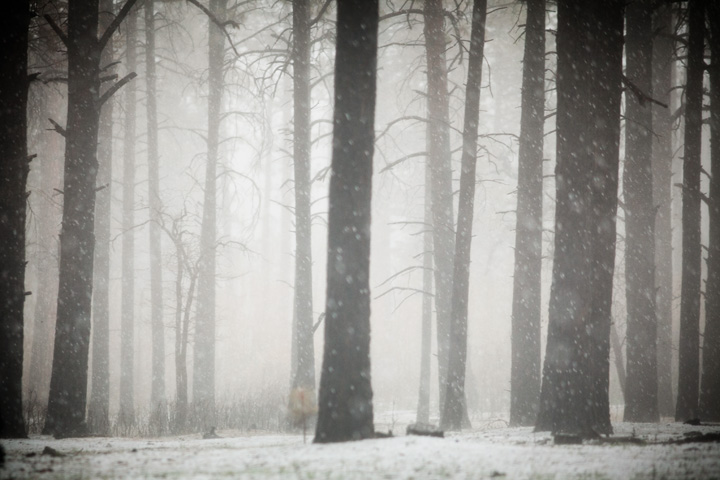 As journalists, we are trained to be neutral, to never betray any hint of bias or emotion. There are exceptions, of course — the 9/11 tragedy was so universally devastating, and so deeply unfathomable, that journalists were permitted to show a sense of loss — in fact, it would have been unthinkable not to.
As journalists, we are trained to be neutral, to never betray any hint of bias or emotion. There are exceptions, of course — the 9/11 tragedy was so universally devastating, and so deeply unfathomable, that journalists were permitted to show a sense of loss — in fact, it would have been unthinkable not to.
But for most of the events and issues we write about, we typically take a one-night-stand approach to our stories: Research the topic, talk to as many knowledgeable people as possible, maybe visit the epicenter of the debate/discovery/crisis, write the story, and then move on to the next one.
But this past summer, after the massive Las Conchas fire swept through my beloved Jemez Mountains, about an hour-and-a-half north of Santa Fe — and visible from some parts of town — something changed. While sitting in my home office writing stories about the fire, which would turn out the be New Mexico’s largest ever, burning much of Bandelier National Monument, Valles Caldera National Preserve and Santa Fe National Forest, I could see — and sometimes smell — the smoke. Friends were evacuated from nearby Los Alamos, some of whom had rebuilt their houses after the Cerro Grande fire had burned through some of the same forest land 11 years before. I wondered what had become of the magnificent canyons and mesas that I had left so many footprints behind in over the years. My heart sank.
I wasn’t the only local science journalist to be shell-shocked by the blaze. My friend George Johnson, a science writer and author who also lives in Santa Fe and was similarly heartbroken by the fire, shared his own reaction in a post on his blog:
“Late in the afternoon the smoke from both fires filters the light and gives everything an eerie orange cast,” he wrote. “Doomsday, it seems, would look like this. I try not to imagine what is happening now to so many of my favorite places: The high meadows of Rancho Viejo where the Rio Capulin flows on its way to meet the Nambe. The Upper Crossing of Frijoles Canyon, one of the only places in New Mexico where I’ve seen fireflies at night. All of that appears to be burning and there is nothing I, or really anyone, can do about it.”
A few weeks later, after the fire had been largely contained, I headed north to Bandelier to see the damage first-hand. It was a Tuesday, a typical sun-drenched northern New Mexico morning. As we approached the monument — my friend Kerry Sherck, a freelance photographer, was riding shotgun — we drove past charred mesas seemingly void of life. Groves of trees beyond the canyon bore testament to the fire’s mosaic burn pattern — total devastation this was not. And having covered fire ecology for many years, I knew that this was a fire-adapted ecosystem, and many of its plants needed fire to propagate. In the long run, this conflagration was a good thing, all the scientists said.
Still, the emotional impact was swift and exact, like a bolt of lightning hitting a tree. And it took me by surprise. After all, I had seen many a burned forest before on previous reporting trips around the West. But this wasn’t just any forest — it was my forest, or at least that’s how I had come to think of it, after spending so much time exploring its trails, running my fingers over the thick sienna-hued bark of its ponderosa pines, bending down to brush my fingers across the smooth purple petals of a pasque flower, hopping across its clear-running streams.
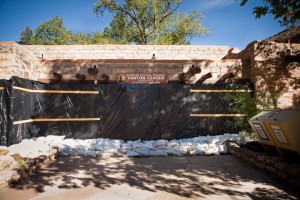 Thanks to some clever maneuvering by firefighters, the fire never touched the heart of Bandelier in lower Frijoles Canyon — it spared the monument’s popular cliff dwellings, the excavated ruins of an Ancient Puebloan village, a New Deal-era visitor center and picnic area. But it wasn’t out of the clear just yet. More than 10,000 white sand bags were piled up five feet high against the walls of the visitor center, which lay just a few feet from Frijoles Creek. Monument officials feared that when the annual monsoon rains began (they were already late), the creek could become a churning flume thick with woody debris and ash, potentially flooding the visitor center, picnic area and the path to the ruins and cliff dwellings. Frijoles Creek was already opaque with ash washed away by occasional light rains.
Thanks to some clever maneuvering by firefighters, the fire never touched the heart of Bandelier in lower Frijoles Canyon — it spared the monument’s popular cliff dwellings, the excavated ruins of an Ancient Puebloan village, a New Deal-era visitor center and picnic area. But it wasn’t out of the clear just yet. More than 10,000 white sand bags were piled up five feet high against the walls of the visitor center, which lay just a few feet from Frijoles Creek. Monument officials feared that when the annual monsoon rains began (they were already late), the creek could become a churning flume thick with woody debris and ash, potentially flooding the visitor center, picnic area and the path to the ruins and cliff dwellings. Frijoles Creek was already opaque with ash washed away by occasional light rains.
Seeing the place I had visited so many times with friends and family barricaded like a fortress was difficult to take in. I imagined what it would be like if the dreaded floods did come — massive erosion, waterlogged historic buildings — and tried to etch the scene of the intact visitor center, trails and picnic area into my memory for future reference.
Our guide for the morning was Rod Torrez, a genial National Park Service interpreter who had been placed on media duty during the blaze and in its aftermath. The main area of the monument was still closed to visitors, so we had to get special permission to enter the area. The visitor center parking lot was eerily quiet for the first week of August — prime tourist season.
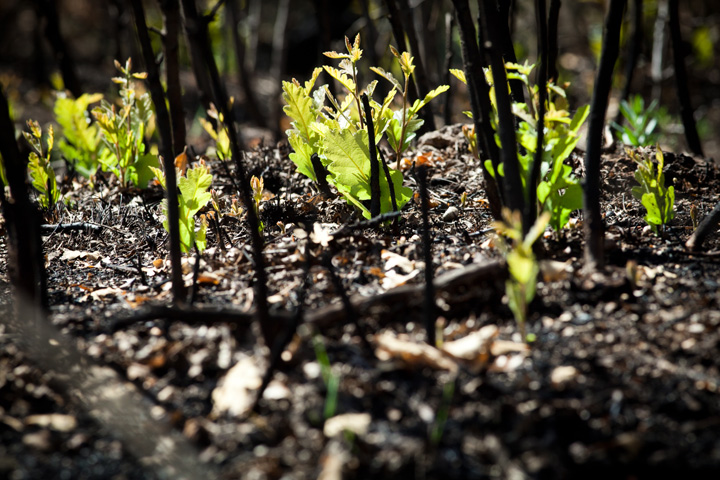 It wasn’t all doom and gloom, though. Later, when Torrez took us up the road to Burnt Mesa (named for a previous fire), and showed us green shoots sprouting from the blackened soil, my heart did a little flip. I knew about post-fire regeneration, and had written about it pretty much every fire season, but here I was watching new life literally rise from the ashes before my eyes, in a place I once thought I knew but had been completely transformed by the flames.
It wasn’t all doom and gloom, though. Later, when Torrez took us up the road to Burnt Mesa (named for a previous fire), and showed us green shoots sprouting from the blackened soil, my heart did a little flip. I knew about post-fire regeneration, and had written about it pretty much every fire season, but here I was watching new life literally rise from the ashes before my eyes, in a place I once thought I knew but had been completely transformed by the flames.
After we completed our tour with Torrez, we headed a few miles up Route 4 to take a look at Valles Caldera National Preserve. Clouds had come to rest above the vast bowl of the preserve, and we could see very little of the caldera (although we did make out some green), so we turned around and headed back. On the way down the mountainside, just as we approached a series of switchbacks, a freak hailstorm began pelting the landscape, the road ahead, and my blue Prius. We pulled over to wait out the worst of it, yelling to each other over the tinny, ear-splitting ruckus that only dime-sized hail balls hitting a car roof can make.
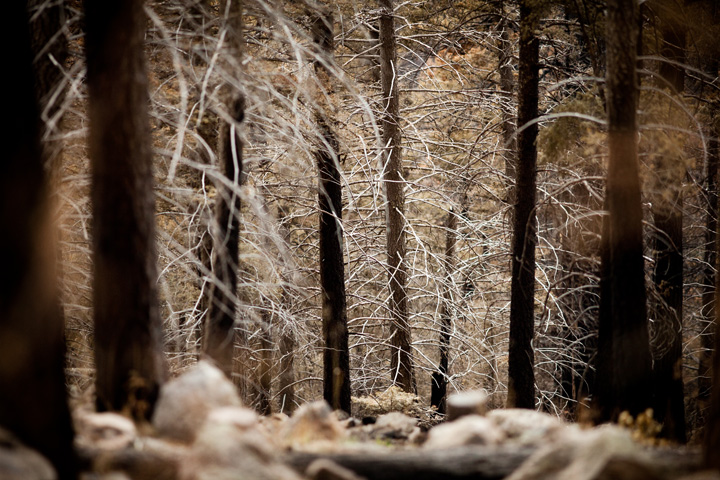 After the hailstorm began to surrender some of its fury, we started back down the mountain, slowly — very slowly. But after less than half a mile, we came to a rockslide in the middle of the road. The torrents of water had quickly eroded rivulets down the mountainside, and rocks, mud and debris blocked our path. With a guard rail on our right, a rock wall on our left, and no shoulder on either side of the road, we did the only thing we could do: We stopped in the middle of the lane and waited. Soon a half dozen other cars were lined up behind us.
After the hailstorm began to surrender some of its fury, we started back down the mountain, slowly — very slowly. But after less than half a mile, we came to a rockslide in the middle of the road. The torrents of water had quickly eroded rivulets down the mountainside, and rocks, mud and debris blocked our path. With a guard rail on our right, a rock wall on our left, and no shoulder on either side of the road, we did the only thing we could do: We stopped in the middle of the lane and waited. Soon a half dozen other cars were lined up behind us.
We wondered what was happening down at Bandelier, whether the creek was rising, and whether the sandbags would hold. I realized I was no longer a detached observer; I was living the very story I was reporting on. I was getting to know it much more intimately than I had ever gotten to know any other story. But what would that mean when I sat down to write the piece? I wondered if I could separate my emotional connection to the story from my telling of it. It was to be a news story, after all — no real room for sentimental impressions.
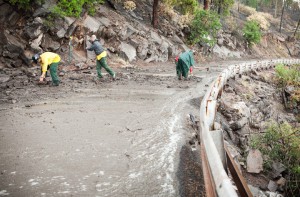 Eventually, some Forest Service guys came along and cleared the roadway, and I went home, wrote the story and turned it in to my editor at Land Letter the next day. (It also ran in the New York Times.) It was a news feature, in keeping with publication’s format, and I think I succeeded in betraying none of my secret ecological despair or my sense of elation in witnessing the forest’s rebirth. But I count it among my favorite stories, and I’d like to think that in this case, my emotional involvement with the subject matter actually made a positive difference in the way the story turned out.
Eventually, some Forest Service guys came along and cleared the roadway, and I went home, wrote the story and turned it in to my editor at Land Letter the next day. (It also ran in the New York Times.) It was a news feature, in keeping with publication’s format, and I think I succeeded in betraying none of my secret ecological despair or my sense of elation in witnessing the forest’s rebirth. But I count it among my favorite stories, and I’d like to think that in this case, my emotional involvement with the subject matter actually made a positive difference in the way the story turned out.
This time, heart won out over head. And I’m all the better for it, I think.
____________
April Reese is a freelance writer based in Santa Fe, New Mexico. She writes regularly for Land Letter, and has also contributed to Smithsonian magazine online, the Christian Science Monitor, Backpacker, Trend and other publications. You can read some of her other work here and here.
All photos taken by and used with the kind permission of Kerry Sherck.
Hi April
It must be darn hard to write articles about places and people you have known. We have seen our share of forest fires here and know the devastation it seems to bring, altho as you have said new growth comes from the ash. This was a nice read. thanks
April – Great piece. I’ve been juggling the same set of issues as I write about the fire’s aftermath for the Albuquerque Journal. My decision has been to go all in – to recognize that my visceral reaction after driving out the Dome Road and up through the flood zone in Cochiti Canyon should be taken as a legitimate clue about what’s really journalistically important here. I’ve always regretted that I didn’t stick with the Cerro Grande fire story long enough after the fact, and made a pledge to myself to follow my gut more closely this time.
Leslie: Thank you for the feedback. Yes, having an emotional investment in a story does make things a little tricker. But I think embracing our humanity as reporters ultimately makes our stories all the richer. I’m curious – where do you live?
John: I think you’re absolutely right. In my experience your gut never steers you wrong. Thanks for all the great water coverage you do for the Journal, by the way.